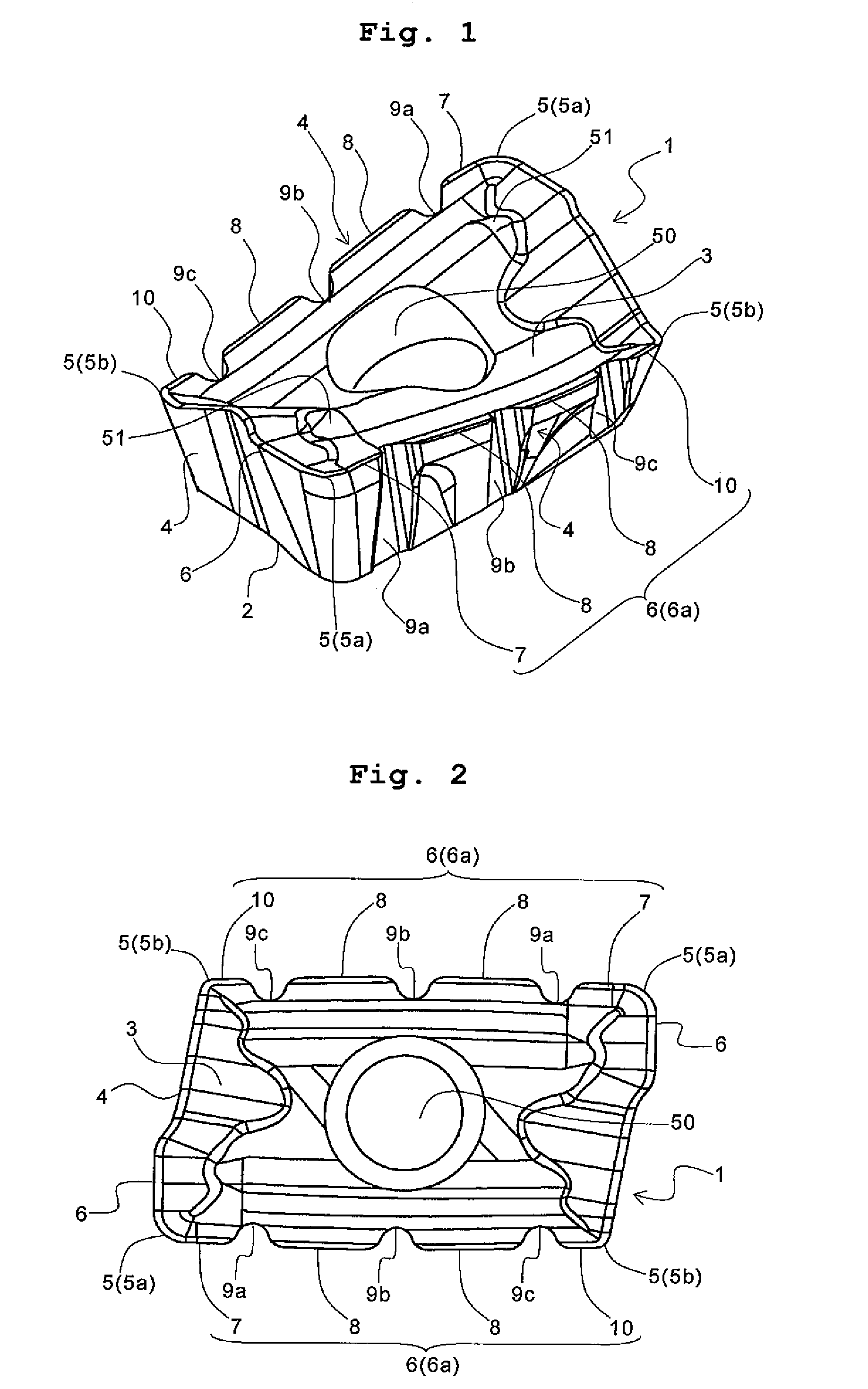Cutting insert, cutting tool using the same, and cutting method
a cutting tool and cutting insert technology, applied in the field of cutting inserts, cutting tools using the same, and cutting methods, can solve the problems of large cutting force of cutting inserts 101 thus constructed, high cutting force, and high vibration risk, and achieves small cutting force, excellent cutting performance, and reduced vibration risk
- Summary
- Abstract
- Description
- Claims
- Application Information
AI Technical Summary
Benefits of technology
Problems solved by technology
Method used
Image
Examples
first preferred embodiment
[0042]A first preferred embodiment of the cutting insert according to the invention is described in detail with reference to the accompanying drawings.
[0043]As shown in FIGS. 1 to 3, the cutting insert according to the first preferred embodiment (hereinafter referred to simply as an insert) 1 comprises an insert main body having substantially a parallelogram when viewed from above. The insert 1 comprises a bottom surface 2 serving as a seat surface, an upper surface 3 having a rake face, and a side surface 4 having a flank. The insert 1 comprises further corner portions 5 (5a and 5b) located at the corner parts of the insert main body in a ridge between the upper surface 3 and the side surface 4, and a cutting edge 6 located between these two corner portions 5 and 5 in the ridge (namely between both ends of the ridge) and connected to these two corner portions 5 and 5.
[0044]The rake face of the upper surface 3 means the face of the upper surface 3, through which generated chips graz...
second preferred embodiment
[0058]A second preferred embodiment next is described with reference to the accompanying drawings. In FIGS. 4 and 5 referred to here, the same references have been used as in FIGS. 1 to 3 for similar parts, and the description thereof is omitted.
[0059]The difference between the insert of the second preferred embodiment and the insert 1 of the first preferred embodiment is the number of grooves formed, that is, the former has four grooves and the latter has the three grooves. Specifically, as shown in FIGS. 4 and 5, an insert 21 of the second preferred embodiment comprises, on a side surface 4 in each longitudinal direction, grooves 22a, 22b, 22c and 22d as a plurality of grooves extending from the side surface 4 to an upper surface 3 to divide a main cutting edge 6a. Thus, the insert 21 has a larger number of the grooves than the insert 1, enabling a further reduction of the cutting force during cutting.
[0060]The groove 22a among these grooves 22a, 22b, 22c and 22d is formed at a re...
third preferred embodiment
[0064]A third preferred embodiment is next described with reference to the accompanying drawing. In FIG. 6 referred to here, the same references have been used as in FIGS. 1 to 5 for similar parts, and the description thereof is omitted.
[0065]The difference between the insert of the third preferred embodiment and the insert 21 of the second preferred embodiment is the formation of the first flank 11, the second flank 12 and the third flank 13 on the side surface extending from the cutting edge-side flank 4a to the bottom surface 2. That is, the former has none of these flanks, and the latter has all of them. Specifically, as shown in FIG. 6, in an insert 30 of the third preferred embodiment, a side surface 4c extending from a cutting edge-side flank 4a to a bottom surface 2 comprises a flank 15, whose clearance angle is gradually changed from a high-positioned corner cutting edge 5a toward a low-positioned corner portion 5b. This simplifies the process of machining the side surface ...
PUM
| Property | Measurement | Unit |
|---|---|---|
| thickness | aaaaa | aaaaa |
| height | aaaaa | aaaaa |
| distance | aaaaa | aaaaa |
Abstract
Description
Claims
Application Information
 Login to View More
Login to View More - R&D
- Intellectual Property
- Life Sciences
- Materials
- Tech Scout
- Unparalleled Data Quality
- Higher Quality Content
- 60% Fewer Hallucinations
Browse by: Latest US Patents, China's latest patents, Technical Efficacy Thesaurus, Application Domain, Technology Topic, Popular Technical Reports.
© 2025 PatSnap. All rights reserved.Legal|Privacy policy|Modern Slavery Act Transparency Statement|Sitemap|About US| Contact US: help@patsnap.com



